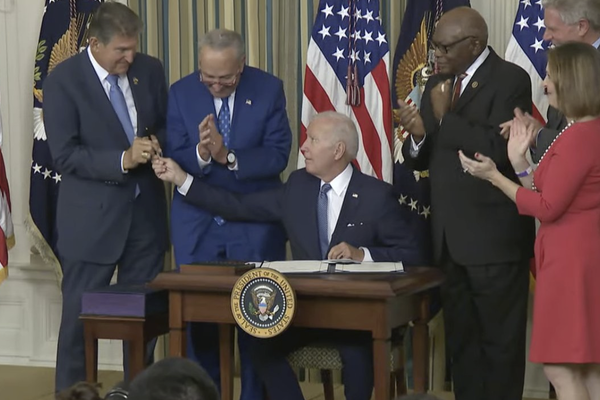President as Change Agent: Breakers vs. Builders

There is an old Yiddish saying: “The only person who likes change is a wet baby.” Change can be frightening. Old methods are jettisoned for new ways of thinking and being. The things we once knew become obsolete and we must learn new and challenging things. Our security blankets are torn from us and we wonder if we can keep up.
In politics, the challenge posed by change was articulated by Niccolo Machiavelli who, in The Prince, noted that “there is nothing more difficult to take in hand, more perilous to conduct, or more uncertain in its success, that to take the lead in the introduction of a new order of things.” And yet, change is often necessary and at times beneficial. The only thing certain is change, and if we do not adjust and adapt to new situations we are likely to be left behind.
In the American system, the President is the Change-Agent-in-Chief. Presidents serve as the defenders of the status quo, challengers to orthodoxy, sources of stability and vehicles for change. Some tear down, others build up. Old orders must be jettisoned, new orders need to be established.
A cycle of stasis and change characterizes the American political system. To everything there is a season, and seasons of change require bold presidential leadership. Our system of government can be stagnant, moribund, sclerotic. Only a president can exert the required pressure to move this system into action.
This cycle of change flows from a predicate (an external threat, a technological threat, a new challenge, for example) and leads to an opening of our sclerotic system, then a leader offers an alternative to the status quo, voters may align themselves with this leader, and then, if skilled and armed with a congressional majority, that president may be able to press for change. But this cycle of stasis or change means that we have either a burst of activity or deadlock—sprint or stand still. We thus suffer from a Goldilocks Dilemma: change is either too hot, or too cold; we can’t seem to get it just right.
The Great Depression of 1929 shattered the bonds citizens had to the status quo, and demands for change, sometimes radical changes, were in the air. That predicate opened the door for Franklin D. Roosevelt and the Democrats to sweep into office, and armed with a large majority in Congress and facing meek opposition by the Republicans, FDR enacted bold changes and remade the system. He created both the welfare state and the administrative state, and vast changes were imposed.
The Cold War was another such external event that animated change. The new threat from the Soviet Union allowed Harry S. Truman to invent the National Security State. In the 1960s, the aspirational leadership of Martin Luther King, Jr. and the impetus of the Civil Rights movement gave Lyndon Johnson the political cover and support to vast changes through the Great Society programs. The attack on 9/11 gave George W. Bush the fuel to create an antiterrorism state.
All these changes were a responses to events – to a predicate that opened a door to power – and presidents offered bold agendas to meet these challenges. Where are we today in this stasis/change nexus?
Today, all national politics revolves around the stark choice of Trump or Biden. The Republicans are afraid to challenge Trump for control of the party, and the Democrats do not have a stable of rivals who could pose a serious threat to Biden. Like it or not, our choice is between The Disruptor and The Incrementalist. In this sense, Donald Trump is the radical, while Biden plays the role of conservative.
Donald J. Trump is a classic disruptor. He knows how to tear things down. But he does not know how to build them back up. Take Obamacare (ACA) as an example. For five years he railed against Obamacare, promising to “repeal and replace” it with “a beautiful thing.” And he tried and tried to destroy Obamacare, but was only marginally successful. However, he never proposed a serious replacement for Obamacare. Likewise, he spent years railing against NATO as obsolete, yet never built an international coalition to replace it. He wanted to drain the swamp and destroy the deep state. But where did he then want to take us?
Joe Biden on the other hand, is a classic incrementalist. His agenda is twofold: first, to shore up democracy across the globe from right-wing populist challenges; and second, to demonstrate that in direct opposition to Trump’s message, he intends to prove that liberal democracy (rule of law, limited government, individual rights, checks and balances) can work for the people. In support of this Biden has led a coalition against Russia’s aggressions in Ukraine, built up NATO (adding Sweden and Finland), and supported democracies abroad. At home, Biden’s “small-bite” reforms have made things better by distributing COVID vaccines, getting unemployment down, passing a Veterans bill, a bill encouraging domestic microchip production, infrastructure funding, health care expansions, climate legislation, prescription drug cost changes and corporate tax increases—and all this with a razor-thin majority in the House and a fifty-fifty split in the Senate. Impressive to say the least. But is it enough?
More disruption and chaos, or more incrementalism and minor changes? We’ve tried them both, and while Trump’s way is exceedingly more exciting and interesting, Biden’s method is more sure and stable. The 2022 and 2024 elections will offer sharp contrasts and clear choices. Shall we tear down a corrupt and self-serving system, or build back better?